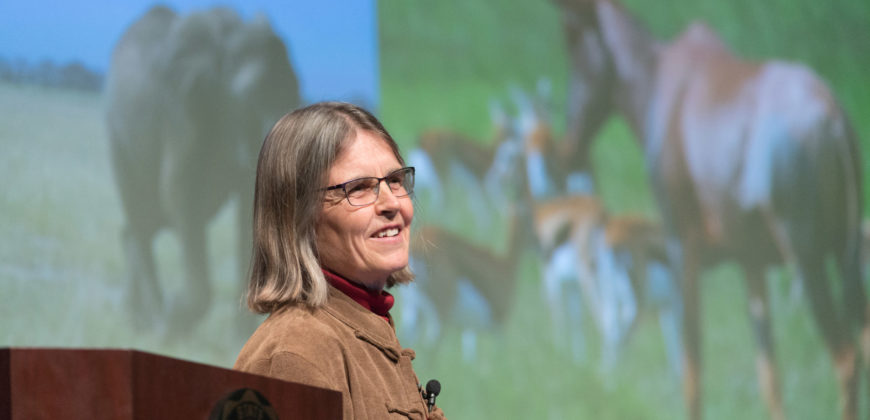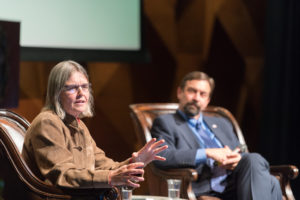Robin Reid: Collaboration is not for the faint-hearted
by Mary Guiden | September 29, 2016 9:04 AM

CSU Professor Robin Reid talks about the value of collaborative conservation at the President’s Community Lecture.
Watch the full lecture here[1].
Robin Reid does not like being called an expert, despite the accolades she’s received for her grasslands research in Kenya, Mongolia and Colorado. Instead, she gives credit to the people she’s collaborated with, individuals that she refers to as “great people” and good friends.
“I am always working very closely with people that live on the land, trying to bring science to help them on issues that they care about,” she said.
Reid, a professor in the Department of Ecosystem Science and Sustainability[2] and head of the Center for Collaborative Conservation[3] at Colorado State University, delivered the eighth President’s Community Lecture in the Lory Student Center Theatre Tuesday night.
In an introductory video[4] that kicked off the event, Reid said she enjoys helping people — students, teams of faculty, community members — reach their potential.
Reid said she has seen the power and magic that can happen when people come together and work on a difficult problem. She collaborated in recent years with the Colorado business community, government officials and others to figure out how to keep the next big wildfire from being as severe as the 2012 High Park fire, the second most destructive fire in the state’s history.
“It takes people with different perspectives, whether they be here in Colorado, Massailand or in Mongolia, to come together and solve a big problem. Sparks fly and a huge amount of stuff gets done,” she said, with a smile.
Massailand is in southern Kenya and northern Tanzania, where the group of people known as the Massai live.
Unexpected discoveries
Reid shared several examples of how she challenged conventional wisdom through her research.
While pursuing a Ph.D. in Rangeland Ecosystem Science at CSU in the 1980s, Reid was investigating the role of herders and their livestock in areas affected by drought and deforestation in Africa. At the time, researchers thought the desert was spreading south because the pastoral people were overusing the land, cutting down too many trees, and because animals were grazing too much on the land. She worked on this subject with the Turkana herders of northern Kenya.
What Reid discovered instead was that the Turkana were, in fact, reforesting and not causing the desert to expand. “That taught me to look for the unexpected, and to not always follow the conventional wisdom,” she said.
Reid, who has brought disparate groups together throughout her career, said that at the local level, people are less divided. “When you get to the local level, you just can’t afford to fight as much, because it’s your dentist you’re fighting or your neighbor,” she said.

In the ranch lands in the West, Reid has explored the question of whether raising cattle is incompatible with conservation, taking into account that cattle are the cornerstone of ranchers’ livelihoods.
The Mountains to Plains Project[5] in the Laramie Foothills, is one of the most remarkable examples in the U.S. of what can happen when city, county, conservationists and ranchers collaborate. “It is amazing,” Reid said.
Outcomes from these collaborative projects extend beyond a beautiful landscape. In Africa, collaborative groups help stop elephant poaching, pay for kids to go to school, help herders get a better price for their livestock, and restore the rangeland to health, thanks to collaborative conservation.
“Why collaborate? It’s not for the faint-hearted. It’s hard work,” Reid said.
Transforming how we do science
Reid’s scientific approach has transformed over the years. While pursuing her graduate degree in Turkana, she said that she wasn’t there to address their problems. “I interviewed them but gave very little back to them,” she said. “I felt terrible about it.”
She subsequently moved away from what she described as the “loading dock” model of science, which maintains the power of scientists as the “experts” and does not integrate others’ or outside knowledge.
Her research evolved into a process of continuous engagement among landowners, communities, non-governmental organizations, government and scientists. She studied up before she did her field work, developed partnerships and found the “middle space” between what was happening on the ground and science.
Through collaborative science with the Maasai people, the team has achieved goals of keeping land open for livestock and wildlife in 100 communities through the Reto-o-Reto project, which translates as “you help us, and we help you.”
Reid said that community members have stopped land grabbers, created the first land-use plans in savannas, doubled the income of poor households, co-designed new Wildlife and Land Acts and created a nationwide network of conservancies. One of the facilitators for this project became a governor, adding to the support for collaborative conservation.
Looking forward
What does the future hold, for all of us? Reid urged audience members to challenge the conventional wisdom, often. “You open up a whole other way of looking at the world,” she said.
She also said that people need to listen more, be humble and try to put themselves in the shoes of someone who is very different. “That opens up doors all around the world,” she said.
In response to a question from a female student seeking advice about the future, Reid said that women are natural leaders in the conservation world.
“We grow up in more of a listening mode,” she explained. “Absolutely follow your gut instinct about what you think is right. You have a different view. Follow it. The world needs that desperately in a very real way. Have confidence that the way you think about things, even if it is different, is really valuable.”
The Department of Ecosystem Science and Sustainability is in the Warner College of Natural Resources.
- here: https://www.youtube.com/watch?v=FDYpBycRkic
- Department of Ecosystem Science and Sustainability: http://warnercnr.colostate.edu/ess-home
- Center for Collaborative Conservation: http://www.collaborativeconservation.org/
- introductory video: https://vimeo.com/183913198
- Mountains to Plains Project: https://www.larimer.org/parks/laramie_foothills.htm
Source URL: https://source.colostate.edu/robin-reid-collaboration-is-not-for-the-faint-hearted/
Copyright ©2024 SOURCE unless otherwise noted.